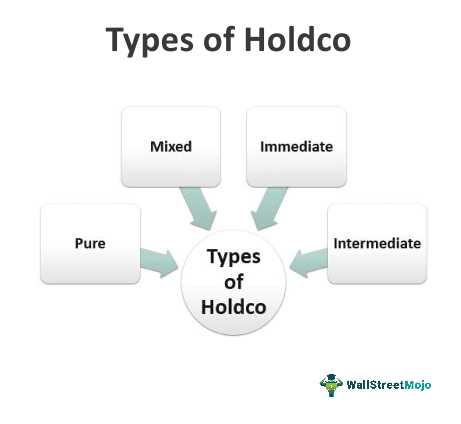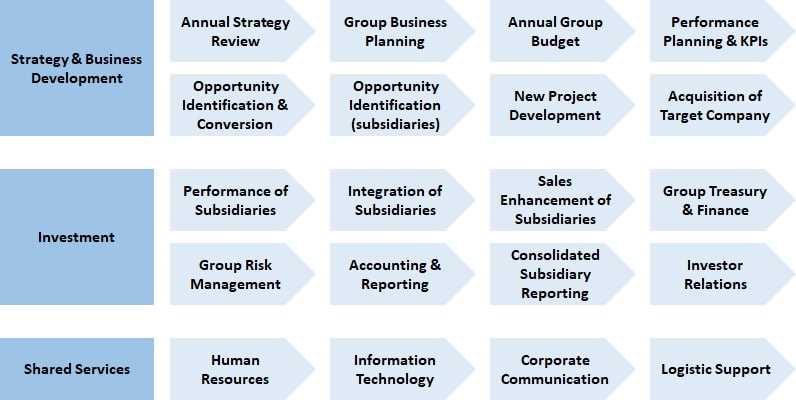What is a Holding Company?
One of the main purposes of a holding company is to provide a centralized structure for managing and controlling multiple businesses. By owning the shares of subsidiary companies, the holding company can exercise control over their operations, strategic decisions, and financial management.
Holding companies are commonly used in various industries, including finance, real estate, and manufacturing. They can be established for a variety of reasons, such as tax planning, risk management, and asset protection.
Unlike operating companies, which are primarily focused on generating revenue and profits, holding companies generate income through dividends and capital gains from their subsidiary companies. This allows them to benefit from the success and growth of their subsidiaries without directly participating in their day-to-day operations.
In summary, a holding company is a business entity that owns and controls other companies. It provides a centralized structure for managing and controlling multiple businesses and allows for various financial and strategic benefits.
Holdco Examples and Overview

Holdcos can be found in various industries and sectors, and their structure and operations can vary significantly. Here are a few examples of successful holding companies:
- Berkshire Hathaway: One of the most well-known holding companies, Berkshire Hathaway owns a diverse range of subsidiaries, including insurance companies, utilities, and consumer goods companies.
- Alphabet Inc.: The parent company of Google, Alphabet Inc. operates as a holding company for various businesses, including Google, YouTube, and Waymo.
- Exor N.V.: Exor N.V. is an Italian holding company that owns significant stakes in companies such as Fiat Chrysler Automobiles, Ferrari, and Juventus Football Club.
- Hutchison Whampoa Limited: Hutchison Whampoa Limited is a Hong Kong-based holding company with subsidiaries in sectors such as telecommunications, ports, and retail.
- SoftBank Group Corp.: SoftBank Group Corp. is a Japanese holding company that has investments in various technology and telecommunications companies, including ARM Holdings and Sprint Corporation.
These examples demonstrate the wide range of industries and companies that can be part of a holding company structure. Holdcos provide a strategic and organizational framework for managing and expanding businesses, allowing for diversification and synergies among subsidiaries.
Overall, holding companies play a crucial role in the corporate landscape, facilitating growth, investment, and strategic decision-making. They offer numerous benefits and advantages, which will be explored further in the following sections of this post.
Definition and Purpose of a Holding Company

One of the main reasons why companies choose to establish a holding company is for the purpose of asset protection. By separating the assets and liabilities of different subsidiaries, a holding company can help mitigate risks and protect the overall financial health of the organization.
Another key purpose of a holding company is to facilitate mergers and acquisitions (M&A). Holding companies can acquire other companies, merge them with existing subsidiaries, or divest certain subsidiaries to streamline operations and maximize profitability.
Benefits of Holding Companies
- Asset Protection: By separating the assets and liabilities of different subsidiaries, a holding company can protect its overall financial health.
- Centralized Control: Holding companies provide a centralized management structure, allowing for better oversight and coordination of subsidiary operations.
- Tax Advantages: Holding companies can take advantage of tax benefits, such as tax deductions and credits, by strategically structuring their subsidiaries.
- Business Expansion: Holding companies can facilitate business expansion by acquiring new subsidiaries or entering into strategic partnerships.
- Efficient Resource Allocation: Holding companies can allocate resources more efficiently by pooling together the financial and operational resources of their subsidiaries.
Examples of Successful Holding Companies
There are numerous examples of successful holding companies across various industries. One notable example is Berkshire Hathaway, led by renowned investor Warren Buffett. Berkshire Hathaway owns a diverse portfolio of subsidiary companies, including insurance, energy, and manufacturing companies.
Another example is Alphabet Inc., the parent company of Google. Alphabet Inc. oversees the operations of Google and its various subsidiaries, such as YouTube, Google Cloud, and Waymo (self-driving cars).
These examples demonstrate the versatility and potential of holding companies in managing and growing a diverse range of businesses.
Benefits and Advantages of Holding Companies
A holding company offers several benefits and advantages for businesses and investors. Here are some key reasons why holding companies are a popular choice:
2. Tax Benefits: Holding companies often enjoy tax advantages, such as lower tax rates on dividends received from subsidiaries or the ability to offset losses in one subsidiary against profits in another. These tax benefits can result in significant savings for the holding company and its shareholders.
3. Asset Protection: Holding companies can be used as a means to protect assets. By separating the ownership of assets from the operating businesses, the holding company shields its assets from potential liabilities and lawsuits that may arise in the subsidiaries.
4. Centralized Control: Holding companies allow for centralized control and decision-making. The holding company’s board of directors can oversee and guide the strategic direction of its subsidiaries, ensuring alignment with the overall corporate objectives.
5. Flexibility in Business Operations: Holding companies provide flexibility in managing various businesses. They can easily acquire or sell subsidiaries, merge businesses, or reorganize the corporate structure to adapt to changing market conditions or business needs.
6. Access to Capital: Holding companies have the ability to raise capital by issuing shares or debt instruments at the holding company level. This provides a centralized source of funding that can be allocated to support the growth and expansion of its subsidiaries.
7. Branding and Reputation: Holding companies can build a strong brand and reputation by associating themselves with successful subsidiaries. This can enhance the overall credibility and market position of the holding company, attracting investors and business partners.
8. Succession Planning: Holding companies offer a structured framework for succession planning. By having a holding company in place, it becomes easier to transfer ownership and control of the business to the next generation or new owners, ensuring continuity and stability.
Overall, holding companies provide a range of benefits and advantages that make them an attractive option for businesses and investors looking to optimize their corporate structure, manage risk, and maximize returns.
Examples of Successful Holding Companies

| Company | Industry | Subsidiaries |
|---|---|---|
| Berkshire Hathaway | Investment | GEICO, Dairy Queen, Duracell, Kraft Heinz, etc. |
| Alphabet Inc. | Technology | Google, YouTube, Waymo, Verily, etc. |
| Exor N.V. | Investment | Fiat Chrysler Automobiles, Ferrari, CNH Industrial, etc. |
| SoftBank Group Corp. | Technology | Arm Holdings, Sprint Corporation, WeWork, Alibaba Group, etc. |
| CK Hutchison Holdings Limited | Conglomerate | Hutchison Whampoa, A.S. Watson Group, Husky Energy, etc. |
These holding companies have successfully managed their subsidiaries and have achieved significant growth and profitability. They have leveraged their diverse portfolios to create synergies, share resources, and capitalize on market opportunities.
By owning multiple companies in different industries, holding companies can spread their risks and reduce their dependence on a single business. This allows them to navigate economic downturns and industry-specific challenges more effectively.
In addition, holding companies often benefit from economies of scale and scope. They can centralize certain functions, such as finance, legal, and human resources, across their subsidiaries, resulting in cost savings and operational efficiencies.
Furthermore, holding companies can unlock value by facilitating strategic partnerships and collaborations among their subsidiaries. They can leverage the expertise and resources of one subsidiary to support the growth and development of another, creating a network effect that enhances the overall competitiveness of the holding company.

Emily Bibb simplifies finance through bestselling books and articles, bridging complex concepts for everyday understanding. Engaging audiences via social media, she shares insights for financial success. Active in seminars and philanthropy, Bibb aims to create a more financially informed society, driven by her passion for empowering others.
